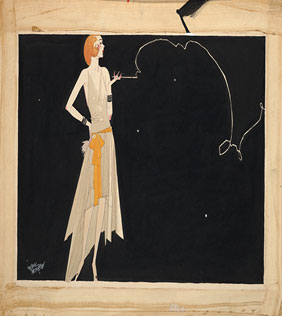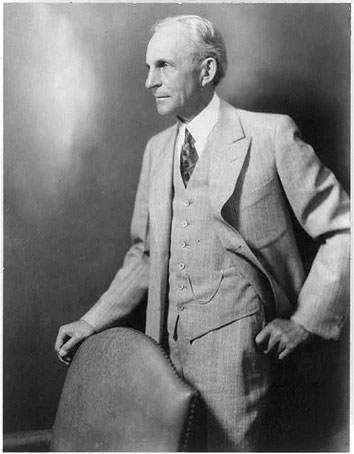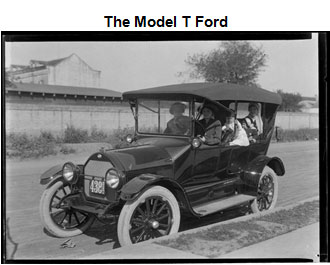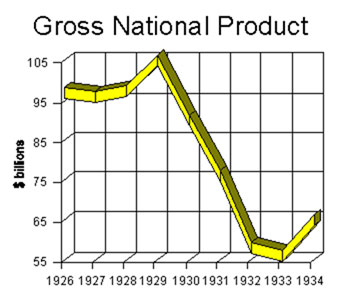
Source: Where There’s Smoke, There’s Fire, Russell Patterson, Library of Congress

Source: Where There’s Smoke, There’s Fire, Russell Patterson, Library of Congress
The 1920s, known as the Roaring Twenties, was a time of many changes - sweeping economic, political, and social changes. There were many aspects to the economy of the 1920s that led to one of the most crucial causes of the Great Depression - the stock market crash of 1929.
In the early 1920s, consumer spending had reached an all-time high in the United States. American companies were mass-producing goods, and consumers were buying. Technology was constantly improving, providing consumers the opportunity to purchase items to make their lives easier. Radios, refrigerators, and washing machines were among the new consumer items being rapidly purchased.
About the painting: The painting on the left is titled Where There’s Smoke, There’s Fire. The woman smoking a cigarette and wearing a revealing dress illustrates the social change of the 1920s.

Source: Photo, Henry Ford, 1863-1947

Source: Model T Ford automobile, Robert Runyon, Library of Congress
The mass-production of the automobile changed the tide of consumer spending in the 1920s. Henry Ford’s implementation of the assembly line to produce the Model T made the car accessible to more consumers by decreasing the price to less than 400 dollars. Businesses began to offer consumers credit, which is the ability to make purchases and pay later in installments.
![]() Click here to watch a video about Henry Ford and the Model T. Answer the questions that follow.
Click here to watch a video about Henry Ford and the Model T. Answer the questions that follow.
Interactive popup. Assistance may be required.
On Ford’s assembly line, each employee was assigned a task, which made production faster and better.
Interactive popup. Assistance may be required.
Ford paid his employees a decent wage so that they would be able to live comfortably and develop a loyalty to the company.

Source: Gross National Product Graph, Social Security Administration
The increase in the production of consumer goods led to the need for more workers who benefitted from the higher wages that were offered. As a result, consumer spending also increased, which benefitted businesses.
During the 1920s, the gross national product (GNP) was well over 105 billion dollars. Seeing the trend of increased sales in business and the chance to make a small fortune, people from all economic backgrounds began to invest in the stock market; some even borrowed funds to invest. Stockbrokers allowed people to buy stocks on margin, which is the practice of investors purchasing stock with borrowed money. Investors expected to cash in enormously because the prices of shares were escalating.
Analyze the graph: According to the gross national product graph, how did the stock market crash impact the GNP in the United States from 1929 to 1932?

By spring of 1929, consumer spending had begun to decline, and manufacturers faced a period of overproduction, resulting in a surplus of goods and a slowdown in production. However, stock prices kept rising, despite the slowdown. On September 3, 1929, the stock market reached its peak. Two days later, the market started to drop.
On October 24, 1929, known as Black Thursday, the stock market began to show signs of trouble, and the bubble eventually burst. Panic set in and investors began selling their shares at an alarming rate. On October 29, 1929, Black Tuesday, the stock market crashed, and shares on the market became worthless. Investors who had bought shares on margin were virtually penniless.
After the crash, chaos ensued in all sectors of the economy. Consumer spending plummeted, factories slowed down production, and companies fired workers. The wages of those still employed were cut, making it hard for people to support their families. American consumers lost their homes to foreclosure and lost (or sold) many of their possessions.
![]() Click on the image to see what is written on the sign.
Click on the image to see what is written on the sign.
Look at the image above and answer the following questions in your notes. Click on the image to read the sign on the car.
Interactive popup. Assistance may be required.
The owner is selling the car for 100 dollars.
Interactive popup. Assistance may be required.
The owner is selling his car because he lost all of his money on the stock market.
Interactive popup. Assistance may be required.
The picture illustrates how Americans lost their possessions as a result of the stock market crash.
Immediately following the crash of the stock market on October 29, 1929, the Great Depression began. For the next ten years, the United States was involved in the worst economic crisis the country had ever faced.